What's New
Displaying results 4531 - 4540 of 4899

Resource | Publications,
Mongolia is a country in North East Asia with a population of 2.5 million. Since 1992 there were 16 cases of HIV/AIDS reported. As of December 2005 the number of HIV/AIDS cases is estimated to be less than 500 cases (WHO/UNAIDS Global Report). Eleven of the 16 reported cases were diagnosed within 2005, while the remaining 5 cases were diagnosed over a period of 12 years.
At the end of 2005, many indications point that Mongolia is at the brink of an HIV epidemic with an imminent risk to the widespread dissemination of HIV to the general population through sexual transmission.
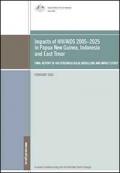
Resource | Publications,
The HIV Epidemiological Modelling and Impact (HEMI) Study was commissioned by the Australian Government for the Governments of Papua New Guinea (PNG), Indonesia and East Timor. The research was conducted by New South Global Pty Limited in 2005.
An epidemiological model was developed to project the future course of the HIV epidemic over the period 2005–2025 in PNG, Indonesia and East Timor under three scenarios. The first scenario assumed that HIV interventions remain at current levels (baseline scenario). The second and third scenarios assumed increases in HIV interventions to medium and high response levels.
Projections of HIV case numbers and deaths were used as a basis to estimate future social, economic and security impacts.
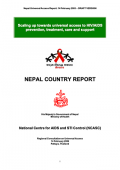
Resource | Publications,
The report that follows will describe the nature of the HIV epidemic in Nepal as well as the performance of the national response, its obstacles, goals, key targets and actions for a scaled-up effort towards universal access.
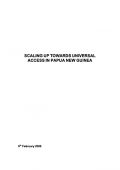
Resource | Publications,
This report presents Papua New Guinea’s response to scaling up towards Universal Access. This new initiative places greater emphasis on scaling up prevention, treatment, care, and support within the country.
The objectives of this report are to:
- Describe the current epidemic in PNG, the patterns and trends, and likely impacts
- Outline the current targets for implementation of the national response
- Provide an overview of what has been achieved to date
- Identify challenges and constraints in implementation primarily within the health sector
- Develop achievable targets for 2010 and a roadmap for implementation.
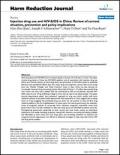
Resource | Publications,
Illicit drug abuse and HIV/AIDS have increased rapidly in the past 10 to 20 years in China. This paper reviews drug abuse in China, the HIV/AIDS epidemic and its association with injection drug use (IDU), and Chinese policies on illicit drug abuse and prevention of HIV/AIDS based on published literature and unpublished official data.
As a major drug trans-shipment country with source drugs from the "Golden Triangle" and "Gold Crescent" areas in Asia, China has also become an increasingly important drug consuming market. About half of China's 1.14 million documented drug users inject, and many share needles. IDU has contributed to 42% of cumulatively reported HIV/AIDS cases thus far. Drug trafficking is illegal in China and can lead to the death penalty. The public security departments adopt "zero tolerance" approach to drug use, which conflict with harm reduction policies of the public health departments. Past experience in China suggests that cracking down on drug smuggling and prohibiting drug use alone can not prevent or solve all illicit drug related problems in the era of globalization. In recent years, the central government has outlined a series of pragmatic policies to encourage harm reduction programs; meanwhile, some local governments have not fully mobilized to deal with drug abuse and HIV/AIDS problems seriously. Strengthening government leadership at both central and local levels; scaling up methadone substitution and needle exchange programs; making HIV voluntary counseling and testing available and affordable to both urban and rural drug users; and increasing utilization of outreach and non-governmental organizations are offered as additional strategies to help cope with China's HIV and drug abuse problem.
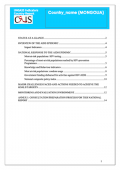
Resource | Publications,
Although the prevalence of HIV and AIDS is still below 0,1 percent among general population, number of new HIV cases is increasing year by year. It is even more alarming the fact that some of the cases are from the general population, not most-at-risk ones.
For Mongolia which has been a somewhat closed country until beginning of 1990, the epidemic of HIV has started relatively later.
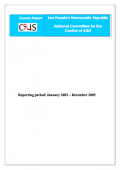
Resource | Publications,
The government of Lao People’s Democratic Republic (Lao PDR) has taken action to prevent the epidemic of HIV/AIDS in the country even before the identification of first case of HIV infection in 1990 and the first person with AIDS in 1992 (NCCA established in 1989). Since then, many HIV prevention projects/programmes have been implementing countrywide. Efforts to fight against HIV epidemic, including STI prevention and treatment, behavioural change communication intervention, peer education, life skills training in school, community based interventions, the 100% condom use programme and other measured approaches have been integrated into general development programmes. On the other hand, capacities on management, coordination, monitoring and evaluation, and research (surveillance, KAP survey, BSS) of NCCA staff are improved.
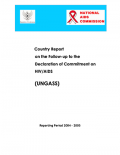
Resource | Publications,
The purpose of this report is to report to UN Secretary General regarding Indonesia’s progress in the fight against AIDS over the period of 2004–2005, by reporting on 9 specific indicators in a manner defined in the UNAIDS Guidelines for the Construction of Core Indicators.
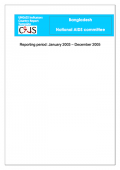
Resource | Publications,
Multisectoral Strategic Plan (2004-2010) exists and a detailed operational plan for scaling up the response up to 2010 is being finalized.
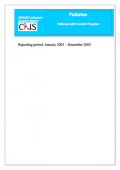
Resource | Publications,
Pakistan at present is categorized as "Low-Prevalence High Risk" country for Human Immunodeficiency Virus (HIV) infection. According to the National AIDS Control Programme/Ministry of Health estimates using WHO/UNAIDS Epiforecast model the number of HIV infected individuals in Pakistan at the end of 2005 are between 70-80, 000 in a total population of 157 million, with a prevalence of 0.1% among general population.





